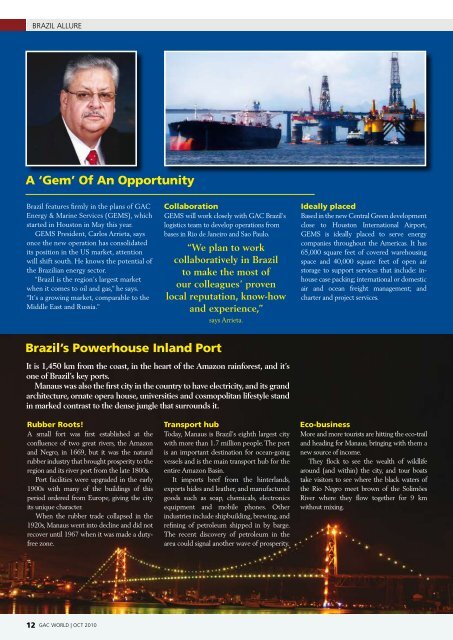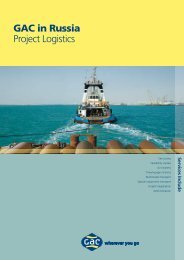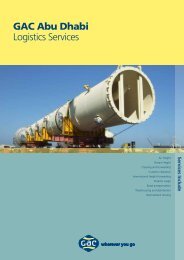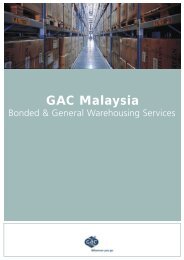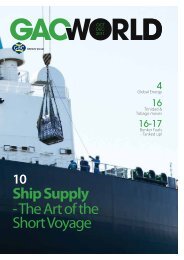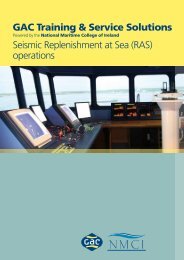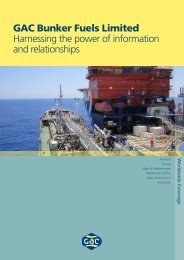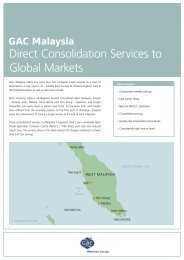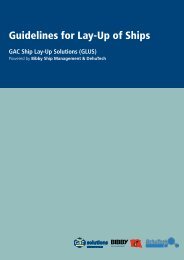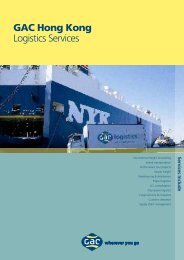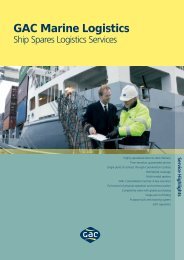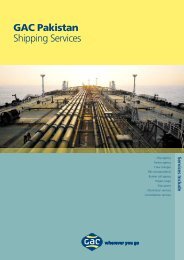GAC World No 4
GAC World No 4
GAC World No 4
You also want an ePaper? Increase the reach of your titles
YUMPU automatically turns print PDFs into web optimized ePapers that Google loves.
BRAZIL ALLURE<br />
A ‘Gem’ Of An Opportunity<br />
Brazil features firmly in the plans of <strong>GAC</strong><br />
Energy & Marine Services (GEMS), which<br />
started in Houston in May this year.<br />
GEMS President, Carlos Arrieta, says<br />
once the new operation has consolidated<br />
its position in the US market, attention<br />
will shift south. He knows the potential of<br />
the Brazilian energy sector.<br />
“Brazil is the region’s largest market<br />
when it comes to oil and gas,” he says.<br />
“It’s a growing market, comparable to the<br />
Middle East and Russia.”<br />
Collaboration<br />
GEMS will work closely with <strong>GAC</strong> Brazil’s<br />
logistics team to develop operations from<br />
bases in Rio de Janeiro and Sao Paulo.<br />
“We plan to work<br />
collaboratively in Brazil<br />
to make the most of<br />
our colleagues’ proven<br />
local reputation, know-how<br />
and experience,”<br />
says Arrieta.<br />
Ideally placed<br />
Based in the new Central Green development<br />
close to Houston International Airport,<br />
GEMS is ideally placed to serve energy<br />
companies throughout the Americas. It has<br />
65,000 square feet of covered warehousing<br />
space and 40,000 square feet of open air<br />
storage to support services that include: inhouse<br />
case packing; international or domestic<br />
air and ocean freight management; and<br />
charter and project services.<br />
Brazil’s Powerhouse Inland Port<br />
It is 1,450 km from the coast, in the heart of the Amazon rainforest, and it’s<br />
one of Brazil’s key ports.<br />
Manaus was also the first city in the country to have electricity, and its grand<br />
architecture, ornate opera house, universities and cosmopolitan lifestyle stand<br />
in marked contrast to the dense jungle that surrounds it.<br />
Rubber Roots!<br />
A small fort was first established at the<br />
confluence of two great rivers, the Amazon<br />
and Negro, in 1669, but it was the natural<br />
rubber industry that brought prosperity to the<br />
region and its river port from the late 1800s.<br />
Port facilities were upgraded in the early<br />
1900s with many of the buildings of this<br />
period ordered from Europe, giving the city<br />
its unique character.<br />
When the rubber trade collapsed in the<br />
1920s, Manaus went into decline and did not<br />
recover until 1967 when it was made a dutyfree<br />
zone.<br />
Transport hub<br />
Today, Manaus is Brazil’s eighth largest city<br />
with more than 1.7 million people. The port<br />
is an important destination for ocean-going<br />
vessels and is the main transport hub for the<br />
entire Amazon Basin.<br />
It imports beef from the hinterlands,<br />
exports hides and leather, and manufactured<br />
goods such as soap, chemicals, electronics<br />
equipment and mobile phones. Other<br />
industries include shipbuilding, brewing, and<br />
refining of petroleum shipped in by barge.<br />
The recent discovery of petroleum in the<br />
area could signal another wave of prosperity.<br />
Eco-business<br />
More and more tourists are hitting the eco-trail<br />
and heading for Manaus, bringing with them a<br />
new source of income.<br />
They flock to see the wealth of wildlife<br />
around (and within) the city, and tour boats<br />
take visitors to see where the black waters of<br />
the Rio Negro meet brown of the Solimões<br />
River where they flow together for 9 km<br />
without mixing.<br />
12 <strong>GAC</strong> WORLD | OCT 2010


